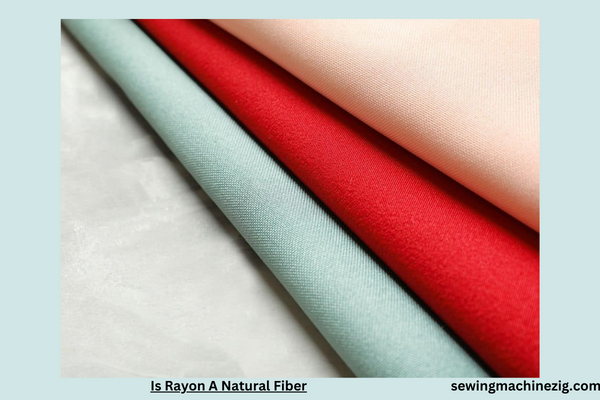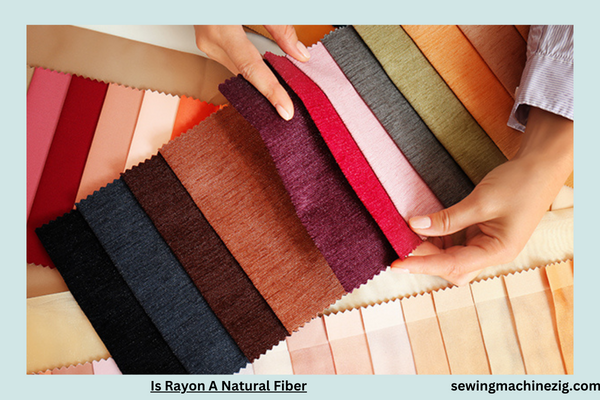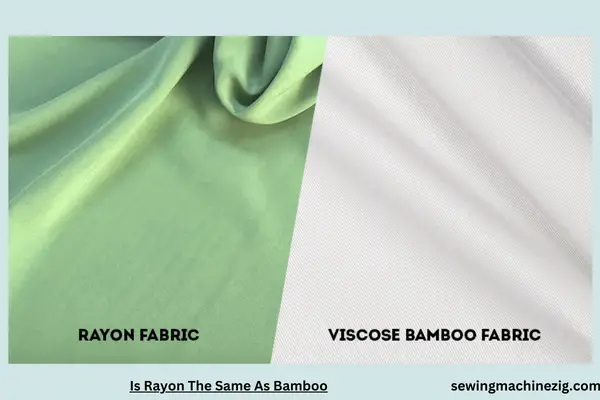
Ever wondered”Is Rayon A Natural Fiber” the fabric mysteries surrounding rayon? Is it a natural fiber or a synthetic impostor? The confusion is real, and I get it. Navigating the textile world can be as puzzling as decoding a fashion enigma.
But fear not! I’m here to unravel the complexities of rayon, making it easy for you to distinguish its true nature. Let’s dive into the fiberscape together, demystifying rayon and providing clarity on whether it’s a natural ally in your wardrobe or a synthetic stranger. Your fabric-related questions are about to find some much-needed answers.
Is Rayon A Natural Fiber Detailed Answer

In the vast world of textiles, the term “Is Rayon A Natural Fiber” often sparks curiosity. Is it a natural fiber, or does it fall into the realm of synthetics?
In this exploration, we embark on a journey to unravel the mysteries of rayon, uncovering its origins, characteristics, and settling the debate on whether it truly qualifies as a natural fiber.
Understanding Rayon:
Rayon is a versatile material that often blurs the lines between natural and synthetic fibers. Derived from wood pulp, primarily that of beech, pine, or bamboo, rayon undergoes a fascinating transformation. The process involves dissolving the wood pulp into a viscous liquid, which is then extruded to form fibers. But does this meticulous process categorize rayon as a natural or synthetic fiber?
The Manufacturing Waltz:
Rayon’s dance between nature and manufacturing begins in the heart of cellulose-rich wood. The wood pulp undergoes a magical alchemy, transforming into a semi-synthetic fiber. This intricate waltz of manufacturing sets rayon apart from truly natural fibers like cotton or silk.
Rayon’s Natural Origins:
While rayon’s manufacturing involves human intervention, its origins lie in nature. The wood pulp, sourced from trees, acts as the starting point, and the process is often heralded for its eco-friendly nature compared to the production of some synthetic fibers. The natural origin of the raw material tinges rayon with a touch of nature.
Characteristics that Echo Nature:
Rayon’s characteristics further reflect its dance with nature. Known for its breathability, moisture absorption, and soft drape, rayon often mimics the qualities of natural fibers. Its comfortable wearability and versatile applications in clothing, home textiles, and beyond underscore its appeal.
Environmental Impact:
As we contemplate rayon’s nature, it’s essential to consider its environmental impact. While the raw material extraction involves trees, a renewable resource, the manufacturing process can vary. Some rayon production methods align with sustainable practices, while others raise concerns about chemical usage and waste disposal. Balancing the natural aspects of rayon with its environmental footprint is crucial in understanding its place in the textile landscape.
Rayon’s Synthetic Stigma:
The synthetic stigma attached to rayon often stems from its manufacturing process, which involves the use of chemicals. Critics argue that this places rayon in the realm of synthetics. However, proponents highlight its biodegradability and the use of renewable resources, emphasizing the harmony between nature and human intervention.
Rayon in Fashion:
Rayon’s versatility extends to the fashion industry, where it has carved a niche for itself. From elegant dresses to casual wear, rayon’s ability to imitate the luxurious feel of silk while offering affordability makes it a favorite among designers and consumers alike. Its soft touch against the skin and comfortable wearability contribute to its popularity in the fashion waltz.
To determine whether rayon qualifies as a natural fiber, it’s essential to acknowledge the fluidity of the fiber spectrum. Situated between natural and synthetic fibers, rayon embodies the best of both worlds. Its natural origins and manufacturing intricacies challenge conventional classifications, urging us to appreciate the nuance in the textile narrative.
Sustainability Considerations:
As sustainability becomes a focal point in textile conversations, rayon’s place in the eco-friendly spectrum comes under scrutiny. Responsible sourcing of wood pulp and adopting environmentally conscious production methods contribute to positioning rayon as a sustainable choice. However, continuous efforts are needed to ensure its journey aligns with nature’s rhythm.
Rayon and Biodegradability:
One of rayon’s eco-friendly qualities lies in its biodegradability. Unlike synthetic fibers that linger in landfills for centuries, rayon gracefully returns to nature. This inherent ability to decompose aligns with the principles of circular fashion, emphasizing a harmonious coexistence with the environment.
Summary:
Is Rayon A Natural Fiber, It is born from wood pulp and crafted through a meticulous manufacturing waltz, embodies the complexity of the fiber spectrum. Its natural origins, characteristics mirroring natural fibers, and sustainable potential challenge the rigid boundaries between natural and synthetic.
As we navigate the textile landscape, understanding rayon’s dance with nature invites us to appreciate the nuances in its story—a story that continues to unfold in the ever-evolving world of fibers and fabrics.
Is Rayon The Same As Bamboo

In the world of textiles, the debate between rayon and bamboo often leads to confusion. Are they one and the same, or do they hold distinct identities?
In this exploration, we embark on a journey to demystify the relationship between rayon and bamboo fabrics, shedding light on their unique qualities, manufacturing processes, and eco-friendly aspects.
Rayon: The Chameleon Fiber:
To understand the relationship between rayon and bamboo, we must first grasp the chameleon-like nature of rayon. Derived from cellulose, typically sourced from wood pulp, rayon undergoes a transformative process to become a versatile and comfortable fabric. But is it the same as bamboo?
Bamboo: Nature’s Green Marvel:
Bamboo, celebrated for its sustainability and rapid growth, has made its mark in the textile industry. The fibers extracted from bamboo undergo processes to create fabrics, presenting an alternative to conventional materials. However, the distinction between bamboo and rayon lies in the intricacies of their manufacturing.
Rayon from Bamboo: The Hybrid Harmony:
The term “rayon from bamboo” emerges as a hybrid that merges the natural origin of bamboo with the manufacturing techniques characteristic of rayon. This harmony creates a fabric that inherits bamboo’s eco-friendly reputation while benefiting from rayon’s softness and draping capabilities.
Manufacturing Rayon from Bamboo:
The manufacturing process plays a pivotal role in distinguishing rayon from bamboo. While both start with bamboo as the raw material, the methods diverge at the processing stage. The viscose process involves dissolving bamboo cellulose, creating a solution that can be spun into fibers—thus, rayon from bamboo is born.
Bamboo Fabric: Natural or Semi-Synthetic?
The debate over whether bamboo fabric is truly natural or semi-synthetic revolves around the manufacturing process. While bamboo itself is undeniably natural, the chemical treatments involved in processing it into fabric have led some to categorize it as semi-synthetic. Striking a balance between nature and human intervention, bamboo fabric presents a unique narrative in the textile landscape.
Distinct Characteristics of Rayon from Bamboo:
Rayon from bamboo inherits certain characteristics from its bamboo origin. Known for its breathability, moisture-wicking properties, and soft texture, it provides a comfortable and eco-conscious option for clothing and home textiles. The distinct qualities of rayon from bamboo contribute to its appeal in various applications.
Eco-Friendly Aspects of Bamboo:
Bamboo, as a raw material, carries a green reputation. Its rapid growth, minimal need for pesticides, and low environmental impact make it an eco-friendly choice. When processed responsibly, bamboo fabric maintains these qualities, aligning with the growing demand for sustainable and renewable materials in the textile industry.
As consumers increasingly prioritize eco-conscious choices, understanding the nuances between rayon and bamboo fabrics becomes essential. It allows individuals to make informed decisions based on their preferences, whether it be the softness of rayon or the eco-friendly allure of bamboo.
Certifications and Responsible Sourcing:
The landscape of rayon and bamboo fabrics is evolving, with certifications and responsible sourcing playing a crucial role. Certifications such as OEKO-TEX and Forest Stewardship Council (FSC) ensure that the production processes meet specific environmental and social standards, providing consumers with reassurance about the sustainability of their chosen fabrics.
Bridging the Gap: Eco-Friendly Innovations:
In the quest for sustainable textiles, innovations are emerging to bridge the gap between rayon and bamboo. Some manufacturers are exploring closed-loop systems, reducing chemical usage and waste in the production of these fabrics. These eco-friendly innovations aim to offer consumers the best of both worlds—soft, comfortable fabrics with minimal environmental impact.
Summary:
In the intricate tapestry of textiles, the distinction between rayon and bamboo becomes a journey of exploration. Rayon, with its chameleon-like nature, meets bamboo, nature’s green marvel, in the creation of rayon from bamboo—a fabric that harmonizes eco-friendliness with softness.
The debate between natural and semi-synthetic takes center stage, encouraging consumers to navigate the landscape of responsible sourcing and certifications. As the textile industry evolves, the story of rayon and bamboo continues to unfold, offering a spectrum of choices that cater to diverse preferences and values.
Conclusion
In conclusion, “Is Rayon A Natural Fiber” Unraveling the nature of rayon reveals a unique textile identity. While not a natural fiber in its pure form, the semi-synthetic origins of rayon, derived from natural cellulose, impart it with characteristics akin to natural fibers.
Whether it’s the comfortable wear or the biodegradable nature, rayon stands as a versatile choice in the textile landscape. Understanding the distinctions clarifies its place in the world of fabrics, offering consumers an informed perspective on their clothing choices.
FAQs – Is Rayon a Natural Fiber:
Q1: Is rayon considered a natural fiber?
A1: No, rayon is classified as a semi-synthetic fiber, as it is derived from natural cellulose, often sourced from wood pulp.
Q2: What sets rayon apart from natural fibers like cotton or wool?
A2: Rayon undergoes a chemical process, transforming natural cellulose into fiber. Unlike cotton or wool, it is not directly harvested from plants or animals.
Q3: Is rayon biodegradable like natural fibers?
A3: Yes, rayon is biodegradable. Its cellulose origin allows it to break down naturally over time.
Q4: Can rayon be considered eco-friendly due to its natural origins?
A4: While derived from natural sources, the chemical processing involved raises environmental concerns. Some argue that truly eco-friendly options might be preferable. “Is Rayon A Natural Fiber“
Q5: Is rayon comfortable to wear, similar to natural fibers?
A5: Yes, rayon is known for its breathability and comfort, often resembling the feel of natural fibers like cotton. “Is Rayon A Natural Fiber“
Q6: How does rayon compare to natural fibers in terms of moisture absorption?
A6: Rayon has good moisture absorption properties, similar to natural fibers, making it comfortable in various climates. “Is Rayon A Natural Fiber“



